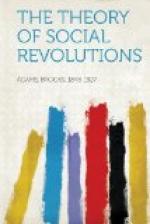successor. And nothing can better illustrate the
inherent vice of the American constitutional system
than that it should have been possible, in 1853, to
devise and afterward present to a tribunal, whose
primary purpose was to administer the municipal law,
a set of facts for adjudication, on purpose to force
it to pass upon the validity of such a statute as
the Missouri Compromise, which had been enacted by
Congress in 1820, as a sort of treaty of peace between
the North and South, and whose object was the limitation
of the spread of slavery. Whichever way the Court
decided, it must have fallen into opprobrium with one-half
the country. In fact, having been organized by
the slaveholders to sustain slavery, it decided against
the North, and therefore lost repute with the party
destined to be victorious. I need not pause to
criticise the animus of the Court, nor yet the quality
of the law which the Chief Justice there laid down.
It suffices that in the decade which preceded hostilities
no event, in all probability, so exasperated passions,
and so shook the faith of the people of the northern
states in the judiciary, as this decision. Faith,
whether in the priest or the magistrate, is of slow
growth, and if once impaired is seldom fully restored.
I doubt whether the Supreme Court has ever recovered
from the shock it then received, and, considered from
this point of view, the careless attitude of the American
people toward General Grant’s administration,
when in 1871 it obtained the reversal of Hepburn
v.
Griswold by appointments to the bench, assumes a sombre
aspect.
Of late some sensitiveness has been shown in regard
to this transaction, and a disposition has appeared
to defend General Grant and his Attorney-General against
the charge of manipulating the membership of the bench
to suit their own views. At the outset, therefore,
I wish to disclaim any intention of entering into
this discussion. To me it is immaterial whether
General Grant and Mr. Hoar did or did not nominate
judges with a view to obtaining a particular judgment.
I am concerned not with what men thought, but with
what they did, and with the effect of their acts at
the moment, upon their fellow-citizens.
Hepburn v. Griswold was decided in conference
on November 27, 1869, when eight justices were on
the bench. On February 1, following, Justice
Grier resigned, and, on February 7, judgment was entered,
the court then being divided four to three, but Grier
having been with the majority, the vote in reality
stood five to three. Two vacancies therefore existed
on February 7, one caused by the resignation of Grier,
the other by an act of Congress which had enlarged
the court by one member, and which had taken effect
in the previous December.
Chief Justice Chase held that the clause of the currency
laws of 1862 and 1863 which made depreciated paper
a legal tender for preexisting debts was unconstitutional.
No sooner had the judgment been recorded than all
the world perceived that, if both vacancies should
be filled with men who would uphold the acts, Hepburn
v. Griswold might be reversed by a majority
of one.




